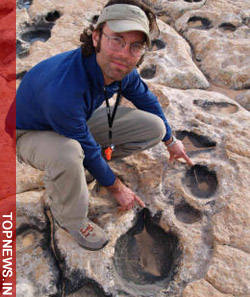‘Dino dance floor’ may be potholes eroded in sandstone
 Washington, Nov 8 : A group of paleontologists have suggested that the ‘dinosaur dance floor’ found in northern Arizona, US, is actually a dense collection of unusual potholes eroded in the sandstone.
Washington, Nov 8 : A group of paleontologists have suggested that the ‘dinosaur dance floor’ found in northern Arizona, US, is actually a dense collection of unusual potholes eroded in the sandstone.
The so-called ‘dinosaur dance floor’ was recently found by geologists from the University of Utah in the US, who claimed to have identified an amazing concentration of dinosaur footprints, located in a wilderness on the Arizona-Utah border.
Located within the Vermilion Cliffs National Monument, the “trampled surface” was determined by the Utah geologists to contain thousands of dinosaur tracks, averaging a dozen per square yard in places.
The tracks, once thought to be potholes formed by erosion, have now been proved to be so by the new research.
According to Marjorie Chan, professor and chair of geology and geophysics, “We went through the proper scientific process of careful study, comparisons with other published works and peer review of the study by independent scientists.”
“We gave the project considerable critical thought and came up with a different interpretation than the paleontologists, but we are open to dialogue and look forward to collaborating to resolve the controversy,” she said.
“There simply are no tracks or real track-like features at this site,” said Paleontologist Brent Breithaupt, director and curator of the University of Wyoming’s Geological Museum.
“We will be investigating the formation of these features in the upcoming study. Science works best when scientists work together,” he added.
Chan and Winston Seiler, who conducted the research as part of his master’s thesis, said that there are strong arguments for the features being potholes rather than dinosaur tracks.
The original study had cited the possibility that the features were potholes and outlined arguments against it.
Chan said that if the features are potholes, they are extremely unusual compared with typical potholes on the Colorado Plateau – and their formation still needs to be explained fully.
She will work with Breithaupt and the others to examine the site in greater detail. (ANI)